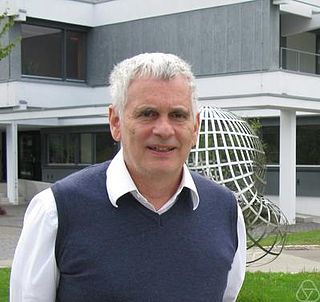
Andrew Pollard Ogg (born April 9, 1934, Bowling Green, Ohio) is an American mathematician, a professor emeritus of mathematics at the University of California, Berkeley. [1]

Andrew Pollard Ogg (born April 9, 1934, Bowling Green, Ohio) is an American mathematician, a professor emeritus of mathematics at the University of California, Berkeley. [1]
Ogg was a student at Bowling Green State University in the mid 1950s. [2] [3] [4] Ogg received his Ph.D. in 1961 from Harvard University under the supervision of John Tate. [5]
Ogg worked in algebra and number theory. His accomplishments include the Grothendieck–Ogg–Shafarevich formula, Ogg's formula for the conductor of an elliptic curve, the Néron–Ogg–Shafarevich criterion and the 1975 characterization of supersingular primes, the starting point for the theory of monstrous moonshine. [6] He also posed the torsion conjecture in 1973 [7] and is the author of the book Modular forms and Dirichlet series (W. A. Benjamin, 1969).
There have been several attempts in history to reach a unified theory of mathematics. Some of the most respected mathematicians in the academia have expressed views that the whole subject should be fitted into one theory.

Richard Ewen Borcherds is a British mathematician currently working in quantum field theory. He is known for his work in lattices, group theory, and infinite-dimensional algebras, for which he was awarded the Fields Medal in 1998.
In number theory and algebraic geometry, a modular curveY(Γ) is a Riemann surface, or the corresponding algebraic curve, constructed as a quotient of the complex upper half-plane H by the action of a congruence subgroup Γ of the modular group of integral 2×2 matrices SL(2, Z). The term modular curve can also be used to refer to the compactified modular curvesX(Γ) which are compactifications obtained by adding finitely many points to this quotient. The points of a modular curve parametrize isomorphism classes of elliptic curves, together with some additional structure depending on the group Γ. This interpretation allows one to give a purely algebraic definition of modular curves, without reference to complex numbers, and, moreover, prove that modular curves are defined either over the field of rational numbers Q or a cyclotomic field Q(ζn). The latter fact and its generalizations are of fundamental importance in number theory.

In mathematics, monstrous moonshine, or moonshine theory, is the unexpected connection between the monster group M and modular functions, in particular, the j function. The term was coined by John Conway and Simon P. Norton in 1979.
In mathematics, an Euler system is a collection of compatible elements of Galois cohomology groups indexed by fields. They were introduced by Kolyvagin (1990) in his work on Heegner points on modular elliptic curves, which was motivated by his earlier paper Kolyvagin (1988) and the work of Thaine (1988). Euler systems are named after Leonhard Euler because the factors relating different elements of an Euler system resemble the Euler factors of an Euler product.

Igor Rostislavovich Shafarevich was a Russian mathematician who contributed to algebraic number theory and algebraic geometry. He wrote books and articles that criticised socialism, and he was an important dissident during the Soviet regime.
John William Scott "Ian" Cassels, FRS was a British mathematician.
In arithmetic geometry, the Weil–Châtelet group or WC-group of an algebraic group such as an abelian variety A defined over a field K is the abelian group of principal homogeneous spaces for A, defined over K. John Tate (1958) named it for François Châtelet (1946) who introduced it for elliptic curves, and André Weil (1955), who introduced it for more general groups. It plays a basic role in the arithmetic of abelian varieties, in particular for elliptic curves, because of its connection with infinite descent.

In mathematics, arithmetic geometry is roughly the application of techniques from algebraic geometry to problems in number theory. Arithmetic geometry is centered around Diophantine geometry, the study of rational points of algebraic varieties.

Karl Cooper Rubin is an American mathematician at University of California, Irvine as Thorp Professor of Mathematics. Between 1997 and 2006, he was a professor at Stanford, and before that worked at Ohio State University between 1987 and 1999. His research interest is in elliptic curves. He was the first mathematician (1986) to show that some elliptic curves over the rationals have finite Tate–Shafarevich groups. It is widely believed that these groups are always finite.

Dorian Morris Goldfeld is an American mathematician working in analytic number theory and automorphic forms at Columbia University.
In the mathematical branch of moonshine theory, a supersingular prime is a prime number that divides the order of the Monster group M, which is the largest sporadic simple group. There are precisely fifteen supersingular prime numbers: the first eleven primes, as well as 41, 47, 59, and 71.
In arithmetic geometry, the Tate–Shafarevich groupШ(A/K) of an abelian variety A (or more generally a group scheme) defined over a number field K consists of the elements of the Weil–Châtelet group WC(A/K) = H1(GK, A) that become trivial in all of the completions of K (i.e. the p-adic fields obtained from K, as well as its real and complex completions). Thus, in terms of Galois cohomology, it can be written as
In algebraic geometry and number theory, the torsion conjecture or uniform boundedness conjecture for torsion points for abelian varieties states that the order of the torsion group of an abelian variety over a number field can be bounded in terms of the dimension of the variety and the number field. A stronger version of the conjecture is that the torsion is bounded in terms of the dimension of the variety and the degree of the number field. The torsion conjecture has been completely resolved in the case of elliptic curves.
In mathematics, umbral moonshine is a mysterious connection between Niemeier lattices and Ramanujan's mock theta functions. It is a generalization of the Mathieu moonshine phenomenon connecting representations of the Mathieu group M24 with K3 surfaces.
In algebraic geometry, Chevalley's structure theorem states that a smooth connected algebraic group over a perfect field has a unique normal smooth connected affine algebraic subgroup such that the quotient is an abelian variety. It was proved by Chevalley (1960), Barsotti, and Rosenlicht (1956).
In mathematics, the Shafarevich theorem, named for Igor Shafarevich, may refer to:
In mathematics, the conductor of an elliptic curve over the field of rational numbers, or more generally a local or global field, is an integral ideal analogous to the Artin conductor of a Galois representation. It is given as a product of prime ideals, together with associated exponents, which encode the ramification in the field extensions generated by the points of finite order in the group law of the elliptic curve. The primes involved in the conductor are precisely the primes of bad reduction of the curve: this is the Néron–Ogg–Shafarevich criterion.

In mathematics, a Siegel modular variety or Siegel moduli space is an algebraic variety that parametrizes certain types of abelian varieties of a fixed dimension. More precisely, Siegel modular varieties are the moduli spaces of principally polarized abelian varieties of a fixed dimension. They are named after Carl Ludwig Siegel, the 20th-century German number theorist who introduced the varieties in 1943.
In hindsight, the first incarnation of Monstrous Moonshine goes back to Andrew Ogg in 1975.